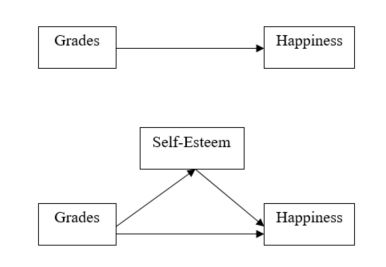Baron and Kenny’s Method for Mediation
A mediator variable is a variable than explains the relationship between a predictor variable and a criterion variable. Mediators tell us how or why something works. The mediator acts as an intervening variable that explains the relationship between a predictor variable and a criterion variable. For the sake of explanation, below is a hypothesized mediation relationship. A simple hypothesis for the first model is that grades in school have a direct relationship on a student’s happiness. The mediation model hypothesizes that grades in school directly affect self-esteem, which in turn directly affects happiness. In other words, we are attempting to establish a chain of influence where grades influence self-esteem, and self-esteem, in turn, influences happiness.

The Baron and Kenny (1986) method is an analysis strategy for testing mediation hypotheses. In this method for mediation, there are two paths to the dependent variable. The independent variable (grades) must predict the dependent variable (happiness), and the independent variable must predict the mediator (self-esteem). Researchers test mediation through three regressions:
Independent variable and mediator predicting the dependent variable. The results must meet the following conditions to support mediation:
Independent variable predicting the dependent variable
Independent variable predicting the mediator
- The first regression equation shows that the independent variable significantly influences the dependent variable.
- The second regression equation shows that the independent variable significantly influences the mediator.
- Mediator must significantly influence the dependent variable in third equation. Here, the independent variable and mediator serve as predictors.
Complete mediation is present when the independent variable no longer influences the dependent variable after the mediator has been controlled and all of the above conditions are met. Partial mediation occurs when the independent variable’s influence on the dependent variable is reduced after the mediator is controlled.
References:
Baron, R. M., & Kenny, D. A. (1986). The moderator-mediator variable distinction in social psychological research: Conceptual, strategic, and statistical considerations. Journal of Personality and Social Psychology, 51, 1173-1182.

If you’re like others, you’ve invested a lot of time and money developing your dissertation or project research. Finish strong by learning how our dissertation specialists support your efforts to cross the finish line.